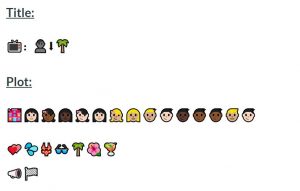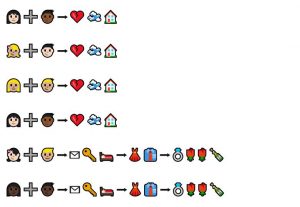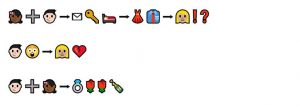Can you guess my emoji story?
This task was a lot of fun, although also frustrating at times! I narrowed down my choices between a few different tv shows I had watched, thinking about the emojis that came to mind for each show, and then finally settled in on one show. I chose to use the online emoji keyboard and started by going through the different categories and choosing all the ones I thought might be needed to explain the show I had chosen. I then used those emojis to start to lay out the plot. Sometimes I had to go back and find an emoji that I was missing, or to see if there was something I could use to represent part of the plot. I tried to start with the title, but then switched to the plot as the title was three words that are all not explicitly represented by a particular emoji and I needed to think more about them. As I worked through the plot, I relied completely on words or ideas. I didn’t use syllables, but I am not exactly sure why. My guess is that certain words are easier to split into syllables and I didn’t run into those words, and/or I tried to sum up a few hours of tv into the plot and didn’t get into nitty, gritty details. I focused more on the main ideas and events of the plot. Overall, I am satisfied with my end result.
The emoji story is an example of “reverse ekphrasis in which images are given the task of explaining words” (Bolter, 2001, p. 56) and this presents some challenges. An arrow pointing down, for example, doesn’t have one specific word associated with it. The arrow pointing down can represent down, in, under, below, south, etc., resulting in different interpretations and taking on different meanings. Each emoji in my story had more power than I realized. I thought putting together the emojis to explain the plot wouldn’t be too hard. The range of interpretations, however, made this task difficult. “By the standard of phonetic writing, however, picture writing lacks narrative power. The picture elements extend over a broad range of verbal meanings: each element means too much rather than too little” (Bolter, 2001, p. 59). Each emoji I added to my story was much more than adding just a word. Each emoji I added brought different meanings and interpretations. Another challenge was the cultural interpretation. I created my emoji story using the emojis that I felt best represented the ideas from the show’s plot, but realized that someone else may interpret the story different based on their background. For example, some cultures interpret a thumbs up as a positive gesture, while other cultures consider it rude. This was a hard obstacle that I could not really overcome due to my lack of knowledge of other cultures interpretations of specific symbols. Lastly, the limited number or emojis presented a challenge for me at times. The characters on the show I used could only be represented by the emojis that were in the online keyboard. Age, skin color, hair color/style etc. were very limited and I just had to make the best choices I could given the limited option. In the title, I really struggled to find an emoji to represent the first word. There were emojis that I thought might be better, but those emojis had specific age, skin color, hair color/style characteristics, so I settled for what I felt was a grayed in, neutral-looking emoji. I didn’t want to impose age, race etc. into the title. I didn’t want my interpretations to impact the reader. The challenges that this task presented really allowed me to see the meaning behind the expression ‘a picture is worth a thousand words.’
References
Bolter, J. D. (2001). Writing space: Computers, hypertext, and the remediation of print (2nd ed.). Mahwah, N.J: Lawrence Erlbaum Associates. doi:10.4324/9781410600110




2 responses to “Task #6 – An emoji Story”